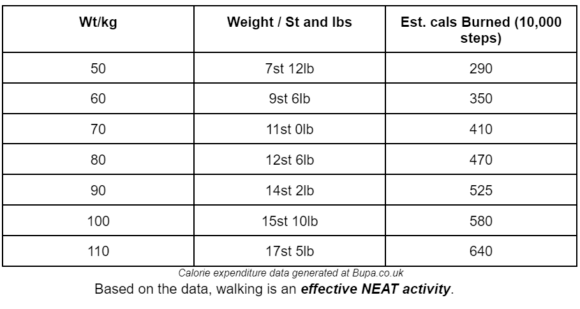

We all enjoy our sweaty sessions in the gym, whether it’s a hardcore HIIT workout, hours spent on a treadmill, a spin class or time spent behind bars lifting or pushing “heavy”. However, in the greater scheme of our overall energy expenditure (calorie burning), for most of us that time is a very small amount of the total hours in our day, week, month or year…
When it comes to looking into our overall activity (and therefore calories burned) with respect to weight loss, we need to look at the time we spend moving away from our favourite exercises in the gym. Calorie burning away from specific exercise is known as “Non Exercise Activity Thermogenesis”, or NEAT for short. NEAT happens all the time and contributes a large part to our overall calorie burning (energy expenditure) during the day. Things like walking, gardening, doing household chores, chasing around after the kids, even *ahem* sex are all examples of NEAT activities. Not just that, but subconscious movements like jiggling your legs when sat at your desk are NEAT actions.

Whilst one could try and track all these NEAT activities, this would be truly a mammoth task and so we generally stick to just one measure that is relatively easy to track, namely how many steps that we manage to take every day. Given that we all have step counters on our phones or smart watches this is an easy win.

Studies have shown that achieving a daily step count of 10,000 steps has a positive impact on a number of health factors when compared against more sedentary individuals. The top benefits of boosting NEAT through doing 10,000 steps/day are:
Walking 10,000 steps/day is a distance of approximately 5 miles. The amount of calories burned doing these 10,000 steps will vary depending on how much you weigh and the speed that you walk at. The below table outlines the approximate calories burned, walking at an average speed of 3 mph for a range of body weights:

Regular walking helps your body know when it’s time to be active and when it’s time to settle in for rest. Research reported by Johns Hopkins Center for Sleep shows there is solid evidence that exercise does help you fall asleep more quickly and improves sleep quality. In fact, the research showed that 30 minutes of moderate aerobic exercise – like walking – can help you fall asleep more quickly and improve the quality of that night’s sleep.
According to the National Sleep Foundation, the rise in body temperature when you walk sends a signal to your brain to decrease your body temperature later in the day, promoting sleep.

Mentalheath.org.uk quotes that “Physical exercise can be very effective in relieving stress”. Research on employed adults has found that highly active individuals tend to have lower stress rates compared to individuals who are less active. It improves self-perception and self-esteem, mood and sleep quality, and it reduces stress, anxiety and fatigue. Physically active people have up to a 30% reduced risk of becoming depressed, and staying active helps those who are depressed recover. In older people, staying active can improve cognitive function, memory, attention and processing speed, and reduce the risk of cognitive decline and dementia.
By increasing the amount of physical activity you do your heart will become stronger. The stronger your heart is the more blood it can pump for less effort. Because a lower effort is needed to pump blood around your body, the forces exerted against your artery walls are lower and so your blood pressure (a measure of the force exerted against you arterial walls) drops. Lower blood pressure results in a reduction in the risk factors associated with Cardiovascular disease.

Cardiovascular disease covers a number of problems such as angina, heart attack, heart failure, stroke and TIAs. Being inactive, having a poor diet, diabetes or even a family history of CVD are all risk factors taken into account. The good news is that walking has been shown to have a positive impact on all of these risk factors. For example, exercise promotes weight reduction and can help reduce blood pressure (see above). Exercise can reduce “bad” cholesterol levels in the blood (the low-density lipoprotein [LDL] level), as well as total cholesterol, and can raise the “good” cholesterol (the high-density lipoprotein level [HDL]). In diabetic patients, regular activity favourably affects the body’s ability to use insulin to control glucose levels in the blood. These changes, if consistently applied, mean a lower risk of suffering from CVD.
So, what are you waiting for, pop those trainers on and get out for a brisk walk.
Get started with Instinct in Tarporley.
By continuing to use the site, you agree to the use of cookies. more information
The cookie settings on this website are set to "allow cookies" to give you the best browsing experience possible. If you continue to use this website without changing your cookie settings or you click "Accept" below then you are consenting to this.